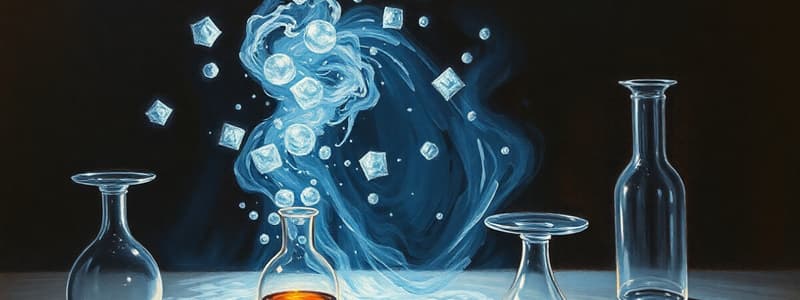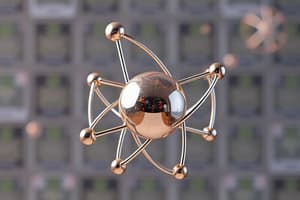Podcast
Questions and Answers
What particles are found in the nucleus of an atom?
What particles are found in the nucleus of an atom?
- Neutrons and Electrons
- Protons and Neutrons (correct)
- Electrons and Positrons
- Protons and Electrons
Which of the following accurately describes metals?
Which of the following accurately describes metals?
- Form acidic oxides and gain electrons
- Lose electrons to form cations (correct)
- Located on the right side of the Periodic Table
- Have properties similar to non-metals
What is the mass number of an element?
What is the mass number of an element?
- Number of electrons in a neutral atom
- Number of protons plus electrons
- Total of protons and neutrons in an atom (correct)
- Number of neutrons in an atom
How did Mendeleev contribute to the study of elements?
How did Mendeleev contribute to the study of elements?
Which process describes the formation of sodium chloride?
Which process describes the formation of sodium chloride?
What is a characteristic of binary compounds?
What is a characteristic of binary compounds?
Which of the following is NOT a property of compounds?
Which of the following is NOT a property of compounds?
What is typically the result of a metal reacting with water?
What is typically the result of a metal reacting with water?
What type of mixture has components that are uniformly distributed?
What type of mixture has components that are uniformly distributed?
Which method is best suited for separating a solid from a liquid?
Which method is best suited for separating a solid from a liquid?
What happens during the rusting of iron?
What happens during the rusting of iron?
Which reaction process is used to extract metals like aluminum?
Which reaction process is used to extract metals like aluminum?
Which of the following is an example of a sign of a chemical reaction?
Which of the following is an example of a sign of a chemical reaction?
In the atomic structure, which particle has a positive charge?
In the atomic structure, which particle has a positive charge?
Which element is an example of an alkaline earth metal?
Which element is an example of an alkaline earth metal?
What describes an isotope?
What describes an isotope?
Which of the following statements about the periodic table is true?
Which of the following statements about the periodic table is true?
Which chemical reaction occurs when chlorine is added to water?
Which chemical reaction occurs when chlorine is added to water?
What best describes fractional distillation?
What best describes fractional distillation?
What is the unit for measuring atomic number?
What is the unit for measuring atomic number?
How many electrons can the first shell of an atom hold?
How many electrons can the first shell of an atom hold?
Flashcards
Atomic Number
Atomic Number
The number of protons in an atom.
Mass Number
Mass Number
The total number of protons plus neutrons in an atom.
Metal
Metal
An element found mostly on the left side of the Periodic Table.
Nonmetal
Nonmetal
Signup and view all the flashcards
Binary Compound
Binary Compound
Signup and view all the flashcards
Compound
Compound
Signup and view all the flashcards
Direct Combination
Direct Combination
Signup and view all the flashcards
Chemical Reaction
Chemical Reaction
Signup and view all the flashcards
Carbonates reaction with acid
Carbonates reaction with acid
Signup and view all the flashcards
Chlorides
Chlorides
Signup and view all the flashcards
Heterogeneous Mixture
Heterogeneous Mixture
Signup and view all the flashcards
Homogeneous Mixture
Homogeneous Mixture
Signup and view all the flashcards
Filtration
Filtration
Signup and view all the flashcards
Decanting
Decanting
Signup and view all the flashcards
Simple Distillation
Simple Distillation
Signup and view all the flashcards
Signs of a Chemical Reaction
Signs of a Chemical Reaction
Signup and view all the flashcards
Word Equation Format
Word Equation Format
Signup and view all the flashcards
Corrosion
Corrosion
Signup and view all the flashcards
Nucleon Number
Nucleon Number
Signup and view all the flashcards
Isotopes
Isotopes
Signup and view all the flashcards
Reactivity of Group 1
Reactivity of Group 1
Signup and view all the flashcards
Study Notes
Atomic Structure and Elements
- Atoms are composed of subatomic particles: protons (positive charge), neutrons (no charge), and electrons (negative charge).
- Protons and neutrons reside in the nucleus, while electrons orbit the nucleus in electron shells.
- Atomic number defines an element, equivalent to the number of protons.
- Mass number is the total number of protons and neutrons.
- Elements are organized by atomic number and properties on the periodic table.
- Over 100 elements are known.
- Metals are typically found on the left and center of the periodic table; non-metals are on the right, and metalloids exhibit properties of both.
Discovering and Organizing Elements
- Scientists identified elements based on their properties (reactivity, state, atomic weight).
- Mendeleev's periodic table left gaps for undiscovered elements and predicted their properties correctly.
- Elements are arranged based on atomic number (increasing from left to right), chemical properties (similar properties in same groups), and electron configuration.
Properties of Metals and Non-Metals
- Metals form basic oxides whereas non-metals form acidic oxides.
- Metals lose electrons to form positive ions (cations), while non-metals gain electrons to form negative ions (anions).
Compounds and Their Formation
- Compounds have different properties than their constituent elements.
- Compounds are formed through chemical reactions (often irreversible).
- Formation methods include direct combination (element+element reaction), reactions with water, and decomposition reactions(breaking apart a compound into simpler substances).
Naming Compounds
- Binary compounds involve two elements: first element keeps its name and the second is modified to end in -ide.
- Ternary compounds—containing three elements—often include polyatomic ions (with specific names).
Common Types of Compounds
- Oxides (basic from metals, acidic from non-metals)
- Hydroxides (bases, neutralize acids)
- Sulfates (minerals, fertilizers)
- Carbonates (react with acids, produce CO₂)
- Chlorides (salts containing chlorine)
Mixtures and Separation Techniques
- Mixtures (heterogeneous: visible components, homogeneous: uniformly distributed components)
- Separating techniques include filtration, decanting, evaporation, simple distillation, fractional distillation, and chromatography.
Extracting Metals from Ores
- Ores are naturally occurring rocks containing metals.
- Extraction methods include roasting, reduction using carbon, and electrolysis.
Chemical Reactions
- Chemical reactions transform substances into new substances with different properties.
- Signs of a chemical reaction include color change, gas production, temperature change, precipitate formation, and odor change.
- Word equations demonstrate reactants transforming to products (reactants → products).
Corrosion, Identifying Chemicals, and Atomic Structure
- Corrosion is the deterioration of materials due to chemical reactions with the environment (like rust on iron).
- Common gas tests (e.g., hydrogen "pop", oxygen relighting a glowing splint, carbon dioxide turning limewater milky) aid in identifying chemicals.
- Atoms have a nucleus with protons and neutrons, and electrons orbiting in specific energy levels (shells).
Periodic Trends and Isotopes
- Periodic trends such as atomic radius, ionization energy, and reactivity show patterns across the periodic table.
- Isotopes are atoms with the same number of protons but different numbers of neutrons.
Group 1 and 2 Elements, and Halogens
- Group 1 (alkali metals) are highly reactive, reactivity increasing down the group.
- Reactions include alkali + water → metal hydroxide + hydrogen.
- Group 2 (alkaline earth metals) are less reactive than alkali metals.
- Group 7 (halogens) show decreasing reactivity down the group.
More Detail on Subatomic Particles
- Protons and neutrons are composed of quarks and held together by the strong nuclear force.
- Electrons are fundamental particles.
- Electrons arrange themselves in specific shells or energy levels with the first shell holding up to 2 electrons; second up to 8; and third up to 8 (for the first 20 elements).
The Discovery of the Nucleus
- Discovery of the nucleus involved Rutherford's gold foil experiment.
Calculations
- Nucleon number = proton number + neutron number
- Understanding the relationships between protons, electrons, neutrons, and nucleon number is important to understanding atoms and isotopes.
Additional Data
- Chlorination of water involves chlorine reacting with water to produce disinfectants, often hypochlorous acid which is active.
Studying That Suits You
Use AI to generate personalized quizzes and flashcards to suit your learning preferences.
Description
Test your knowledge on atomic structure, subatomic particles, and the organization of elements on the periodic table. This quiz covers essential concepts regarding the mass number, atomic number, and the classification of elements. Perfect for students exploring chemistry fundamentals.




